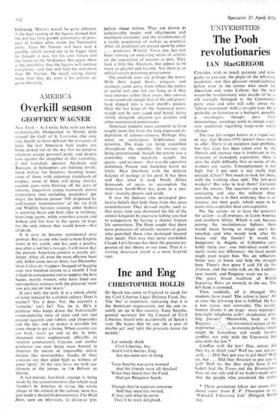AMERICA
Overkill season
GEOFFREY WAGNER
New York— As I write, baby seals are being systematically bludgeoned to bloody pulp around the Gulf of St Lawrence (the only area legally to have delayed the massacre of late), the last American bald eagles are being picked out of the sky (for no purpose whatever except personal pride, and despite laws against the slaughter of this vanishing, if not vanished, species), Alaskans and Russians in helicopters are hunting lovely, timid wolves for bounties (heading home, some of them, with sickening truckloads of corpses, some of them still dying slowly), cyanide guns were blowing off the jaws of anxious, inquisitive young mammals almost everywhere (not excluding picnickers' pet dogs), the hideous poison '108' dispensed by well-named 'exterminators' of the us Fish and Wildlife Services (among other bodies) is screwing beast and bird alike in writhing, hour-long agony, while countless coyote and bobcat and fox wait in the agony of traps for the only release they would know—that of death.
It is easy to become sentimental over animals. But as one who used to hunt English foxes in his youth, and has seen a poultry pen after a red fox's ravages, I still insist that the present American context is totally dif- ferent. After all, even the most efficient hunt only killed some two or three; last December three Colorado 'trappers' bragged of bagging over two hundred coyote in a month. I find it hard in consequence not to support the lean bands, mostly women, who have lined our metropolitan avenues with the placards 'STOP 1 HE KILLING OF THE SEALS.'
It isn't only the seals. It is a whole cliché of mind induced by a citified culture. Does it matter? Yes it does. Yet, the coyote's a 'varmint,' isn't he? Yes, he is. He's a predator who keeps down the fantastically overpopulating mess of mice and rats and ground squirrel and rabbits and chipmunks and the like, and so makes it possible for some sheep to get a living. When coyotes are cut back, roots go and so do, in time, sheepmen (now euphemised, officially, as 'mutton conductors'). Coyotes and similar predators are now being mass hunted in America by means of impossibly unfair devices like snowmobiles. Stacks of their carcases are then piled high as witness of great 'sport.' At the very least, we took our chances at the jumps, in the Belvoir or Quorn.
A last-minute, last-ditch attempt is being made by the conservationists (for which read 'cranks') in America to revise the whole image of the animal in the culture. mum has just made a beautiful documentary The Wolf Men, seen on television, to dissipate pre- judices about wolves. They are shown as unbelievably tender and affectionate and intelligent creatures, and the maintenance of a viable population of wolves as essential. After all, predators are preyed upon by other . . . predators. Wildlife News, too, has just been running an endearing series of articles on the acquisition of coyotes as pets. They look a little like Alsatians, but appear to be twice as playful and lovable. Yet there is an official coyote poisoning programme.
The roadside zoos are perhaps the worst. With their caged bears, cougars, and monkeys yards away from where the tatters of useful owl and fox are hung as if they were enemies rather than assets, they answer to no standards except that of the odd green- back slipped into a local sheriff's pocket. Here the last kings of the American coun- tryside can be seen caged and bored, dying slowly alongside adjacent gas stations and other commercial concessions.
American students seem currently to have caught some fire from the long expressed in- dignation of conservationists. Perhaps they sense an analyogous helplessness and minority. The traps are being assembled throughout the republic, the coyotes are being exterminated, though the coyote was a controller who regularly caught his quota—and no more: that was the operative definition. Poison and buckshot know no limits. Man interferes with the delicate balance of ecology at his peril. It has been said that what it took North Africa thousands of years to accomplish the American South-West has done in a cen- tury—namely, deserts and scrub.
It was the Indians who developed pro- tective beliefs that held them from this mass extermination. They devised myths, such as that every time you shortened the life of the animal kingdom by excessive killing you had to compensate by having a shorter human life somewhere. The Hopi taught that there were protectors of animals, masters of game who punished those who destroyed beyond their needs. That way they never overkilled. Claude Levi-Strauss has been the greatest ex- positor of this theory in our time. That it is stirring American youth is a most hopeful sign.






































 Previous page
Previous page